Rotes Höhenvieh
The Rotes Höhenvieh is a breed of red cattle from the Central Uplands of Germany. It was created in 1985 as a merger of the few remaining examples of a number of closely similar regional breeds of upland red cattle. Reconstruction of the breed was made possible by the discovery of a stock of semen in a sperm bank. The name means "red upland cattle".
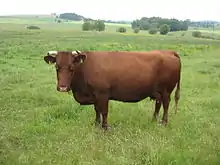 German Red (Highland type) cow | |
| Conservation status | FAO (2007): endangered[1] GEH Red List: II, seriously endangered |
|---|---|
| Other names | German Red (Highland type)[2] |
| Country of origin | Germany |
| Distribution | Central Uplands |
| Use | formerly triple-purpose: meat, milk, draught[3] now meat, vegetation management[4] |
| Traits | |
| Weight | |
| Height | |
| Coat | red, with pale muzzle[5] |
| Horn status | horned |
| |
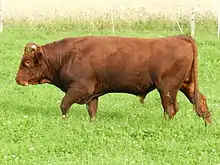
History
The mechanisation of agriculture in the years after the Second World War meant that the draught power of the traditional upland red cattle of the Central Uplands was no longer required. They became essentially useless, and by about 1980 had all but disappeared. Recovery of the breed was based on about 20 cows, not pure-bred but retaining some characteristics of the old breed, and on the rediscovery in the Zentralbesamungsstation or semen collection centre of Giessen, in Hesse, of about 60 doses of semen from a pure-bred bull.[6]
Rotes Höhenvieh, was the first variety of German Red (ger. Deutsches Rotvieh) that adopted a recovery plan. Other local varieties of the combined German Red herdbook reasserting their identity were the Red Wittgenstein, of Siegen-Wittgenstein (North Rhine-Westphalia), the Bavarian Red, the Thuringian Red (ger. Thüringer Rotvieh), the Harz cattle (ger. Harzer Rotvieh) and the Vogtland cattle. Westerwald cattle and Kelheimer cattle got completely absorbed into German Red cattle. Their trace is lost.[2]
Numbers of the Rotes Höhenvieh have risen steadily in recent years, from 387 in 1997 to 1521 in 2012.[4][7] It was listed as "endangered" by the FAO in 2007,[1] and is listed as "Category II: seriously endangered" on the Rote Liste or red list of the Gesellschaft zur Erhaltung alter und gefährdeter Haustierrassen.[8] It was named the "endangered breed of the year" by the GEH in 1997.[9]
Use
Rotes Höhenvieh cows give about 4000 kg per lactation; the milk has 3% fat and 4% protein.[5]
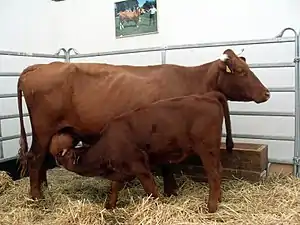 Cow with calf
Cow with calf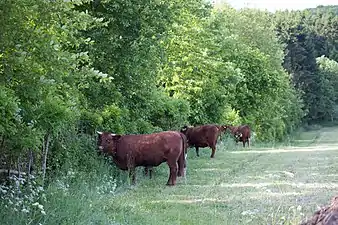 Use in vegetation management
Use in vegetation management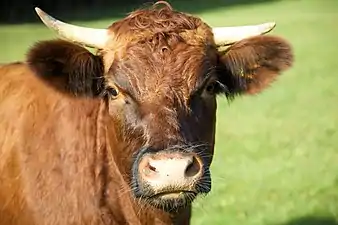 Head of a bullock
Head of a bullock
References
| Wikimedia Commons has media related to Rotes Höhenvieh. |
- Barbara Rischkowsky, D. Pilling (eds.) (2007). List of breeds documented in the Global Databank for Animal Genetic Resources, annex to The State of the World's Animal Genetic Resources for Food and Agriculture. Rome: Food and Agriculture Organization of the United Nations. ISBN 9789251057629. Accessed October 2014.
- Porter, Valerie. Mason's World Encyclopedia of Livestock Breeds and Breeding, p. 185, at Google Books
- Das Rasseportrait: Rotes Höhenvieh (in German). Vielfältige Initiative zur Erhaltung gefährdeter Haustierrassen. Accessed October 2014.
- Breed data sheet: Rotes Höhenvieh/Germany. Domestic Animal Diversity Information System of the Food and Agriculture Organization of the United Nations. Accessed October 2014.
- Rassebeschreibung Rind: Rotes Höhenvieh (in German). Bundesanstalt für Landwirtschaft und Ernährung: Zentrale Dokumentation Tiergenetischer Ressourcen in Deutschland (TGRDEU). Accessed October 2014.
- Jörg Bremond (1994). Schwerpunkt - Rinder: Das Rote Höhenvieh (in German). Gesellschaft zur Erhaltung alter und gefährdeter Haustierrassen. Accessed January 2017.
- Das Rotes Höhenvieh (in German). Gesellschaft zur Erhaltung alter und gefährdeter Haustierrassen. Accessed January 2017.
- Rote Liste der GEH e.V. Archived 16 November 2016 at the Wayback Machine (in German). Gesellschaft zur Erhaltung alter und gefährdeter Haustierrassen. Accessed January 2017.
- Gefährdete Nutztierrasse des Jahres (1997 bis 1999) (in German). Gesellschaft zur Erhaltung alter und gefährdeter Haustierrassen. Accessed January 2017.